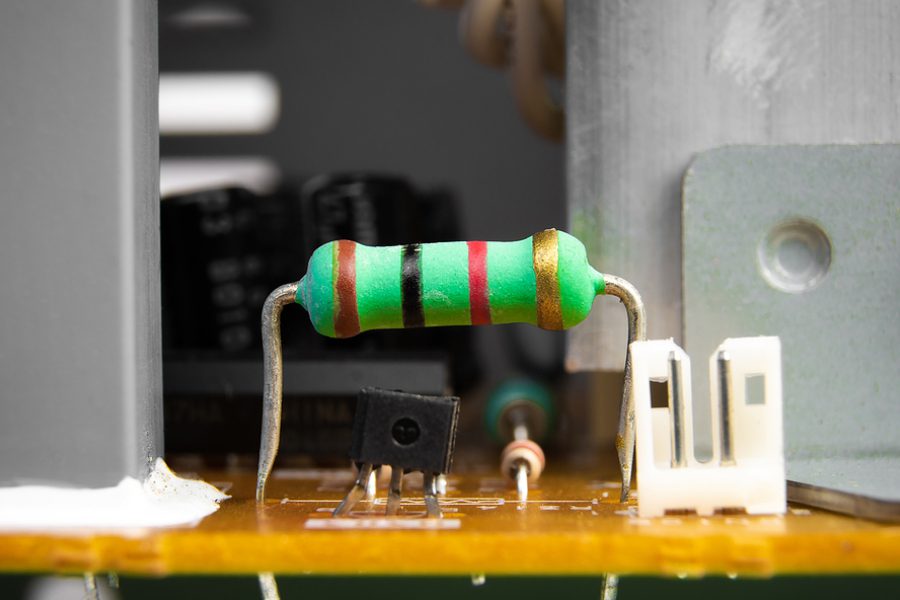In electronics, components such as resistors stand as humble yet essential pillars of circuitry. This article aims to unveil the enigma surrounding resistors by providing insights into their nature, functionality, and the various types that exist.
What is a Resistor?
A resistor is an electronic component designed to control the flow of electric current within a circuit. It adds a level of resistance, measured in ohms (Ω), to the movement of electrons.
How Resistors Work
Resistors operate on the principle of Ohm’s law, named after the German physicist Georg Simon Ohm. According to Ohm’s law, the current flowing through a conductor (like a resistor) is directly proportional to the voltage applied across it, and inversely proportional to the resistance of the conductor. This relationship can be mathematically expressed as:
I = V / R
In this equation:
I represent the current in amperes (A).
V signifies the voltage in volts (V).
R denotes the resistance in ohms (Ω).
Resistors are typically made from highly resistant materials like carbon, metal films, or ceramics. When a voltage is applied across a resistor, an electric field forms, opposing the electron flow. This opposition leads to the conversion of electrical energy into heat energy, which dissipates into the surrounding environment.
Types of Resistors
- Fixed Resistors
Fixed resistors, as the name suggests, are passive electronic components with a predetermined and unchangeable resistance value. They are foundational building blocks in electronics, serving a multitude of purposes in various circuits and devices.
Types of Fixed Resistors
- Carbon Composition Resistors: These resistors consist of a mixture of carbon particles and a binder material, forming a cylindrical shape. They offer a wide range of resistance values but exhibit relatively high tolerance and temperature coefficient. They are often used in low-cost applications where precision is not critical.
- Film Resistors: These resistors feature a thin film of resistive material (often metal or metal oxide) deposited on a ceramic substrate. They offer better stability, precision, and lower noise compared to carbon composition resistors.
- Metal Oxide Resistors: These resistors use a metal oxide film as the resistive element. They exhibit improved stability, higher power handling capacity, and better tolerance compared to carbon composition resistors.
- Wirewound Resistors: These resistors consist of a resistive wire wound around an insulating core. They offer excellent precision, high power handling, and low noise characteristics. Wirewound resistors are commonly used in applications requiring accurate and stable resistance values.
- Variable Resistors
Variable resistors are dynamic components that allow for adjustable resistance in electronic circuits. Unlike fixed resistors, these components enable real-time tuning of resistance values, making them indispensable for applications requiring precise control and adaptability.
Types of Variable Resistors
- Potentiometers: Potentiometers are three-terminal devices with an adjustable wiper that moves along a resistive track. They can be utilised in a variety of circuits as voltage dividers, attenuators, and control elements.
Linear pots offer a uniform change in resistance, while logarithmic pots provide a logarithmic change in resistance, mimicking human perception in applications like audio volume control.
- Rheostats: Rheostats are two-terminal variable resistors used primarily for controlling current. By adjusting the resistance, they limit the current flowing through a particular part of the circuit. Rheostats find applications in tasks such as motor speed control and lamp dimming.
- Specialised Resistors
Specialised resistors are designed to fulfil specific requirements beyond the scope of standard resistors. These resistors are engineered to exhibit unique characteristics or respond to particular stimuli, making them indispensable in applications with distinct demands.
Types of Specialised Resistors
- Thermistors
- NTC (Negative Temperature Coefficient) Thermistors: These resistors have a resistance that decreases as temperature rises. They are used in temperature measurement, compensation, and control applications.
- PTC (Positive Temperature Coefficient) Thermistors: The resistance of PTC thermistors increases with temperature. They are used in overcurrent protection, self-regulating heaters, and motor starting applications.
- Surface Mount Resistors: Surface Mount Resistors (SMD) are designed to be directly mounted onto the surface of printed circuit boards (PCBs) during assembly, eliminating the need for leaded components and enabling automated manufacturing processes. These compact components have transformed the electronics landscape with their efficiency, miniaturisation, and compatibility with modern assembly techniques.
- Light-Dependent Resistors (LDRs): Also known as photoresistors, LDRs exhibit changes in resistance based on the intensity of light. They are used in light-sensing applications like automatic lighting, photography exposure control, and solar-powered devices.
- Precision Resistors: Precision resistors are known for their exceptional accuracy and stability in terms of resistance values. These specialised resistors are designed to provide extremely precise resistance values with minimal variation, making them essential in applications where high accuracy is paramount.
- Power Resistors: Power resistors are specialised resistors designed to handle and dissipate significant amounts of electrical power without undergoing thermal degradation. These robust components are crucial for applications where high-power levels must be managed while maintaining stability and reliability.
- Fusible Resistors: Fusible resistors, also known as fuse resistors or fusing resistors, are specialised components that combine the functions of resistors and fuses in a single package. These unique resistors are designed to provide both resistance value and a safety mechanism that protects circuits from overcurrent conditions.
- Metal Oxide Varistors (MOVs): These non-linear resistors exhibit a high resistance at low voltages and a low resistance at high voltages. They protect circuits from transient voltage spikes and surges, commonly caused by lightning or other electrical disturbances.
Conclusion
Resistors might be small components, but their impact on electronics is immense. From regulating current to dividing voltage, they are the unsung heroes that enable circuits to function effectively.
Wiselink is a globally trusted online electrical components store, dedicated to supplying you with top-quality resistors and a diverse range of components to enhance your circuitry. Our commitment to excellence ensures that you receive reliable components that matches your specifications.
Explore our comprehensive catalogue today, which encompasses pogo pins, reed relays, and more, and discover the difference that quality electronic components can make in your electronic designs.

